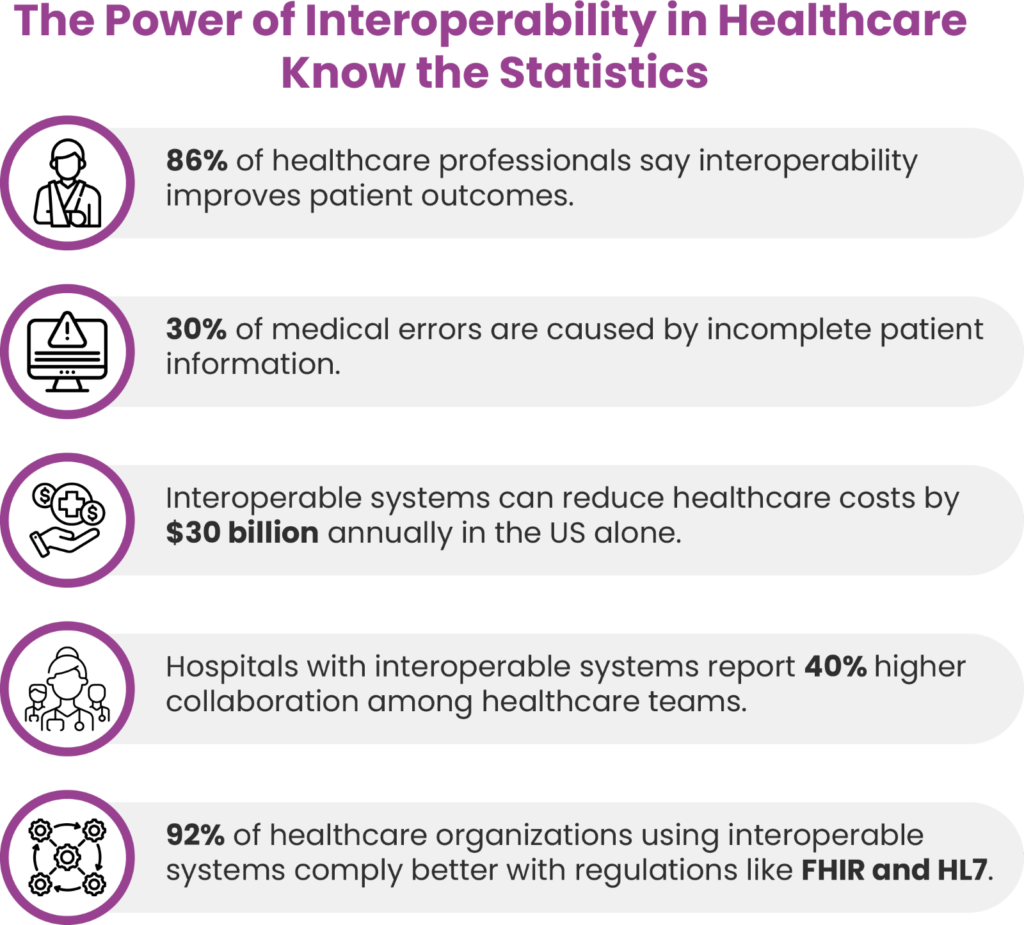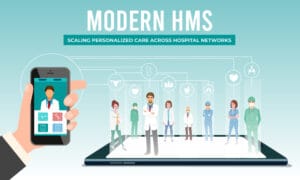
Imagine this: You’re at the doctor’s office, and they need your medical history. You’ve seen multiple specialists, had tests at different clinics, and even used a fitness tracker. But getting all that information together feels like a giant puzzle with missing pieces. This is where interoperability in healthcare comes in.
What is the role of interoperability?
Think of interoperability as the ability of different healthcare systems to “talk” to each other and seamlessly share information. It’s like having a universal language for all medical records. This allows doctors to access your complete medical history, from past surgeries and medications to allergies and lab results, no matter where you received care. This means:
- Better-informed decisions: Doctors have a complete picture of your health, leading to more accurate diagnoses and more effective treatment plans.
- Reduced medical errors: Having all the information in one place helps avoid dangerous medication interactions or duplicate tests.
- Improved patient safety: Easier access to critical information can help prevent medical errors and improve patient outcomes.
- Increased efficiency: Less time spent searching for information means more time for patient care.
What are the 3 levels of interoperability required to exchange data?
- Findability: This is the basic level. It’s like knowing a hospital or doctor exists. It’s about knowing where to find the information, even if you don’t know exactly how to get it.
- Accessibility: This is like knowing the hospital’s address and being able to get there. It means you can actually access the data, but it might not be in a format you can easily understand.
- Usability: This is the gold standard. It’s like arriving at the hospital and being greeted by a friendly receptionist who can help you find what you need. This means the data is not only accessible but also understandable and usable by the healthcare providers who need it.
What is data exchange and interoperability?
Data exchange is simply the sharing of information between different systems. Interoperability ensures that this data exchange is seamless and meaningful. It’s like translating information between different languages so everyone can understand it.
How do you achieve data interoperability?
Achieving true interoperability requires a multi-pronged approach:
- Standardization: Establishing common standards and protocols for data exchange is crucial. Think of it like everyone agreeing to speak the same language.
- Technology infrastructure: Reliable and secure technology infrastructure is essential for transmitting and storing data.
- Data governance: Clear policies and regulations are needed to ensure the secure and responsible sharing of patient data.
- Collaboration: Collaboration between healthcare providers, technology vendors, and government agencies is vital to overcome challenges and drive interoperability forward.
Interoperability in healthcare examples
- Imagine a patient with diabetes: If their doctor and endocrinologist can easily share information about their blood sugar levels, medication, and recent appointments, they can work together to create a more effective treatment plan.
- During a medical emergency: First responders can quickly access a patient’s medical history, including allergies and existing conditions, enabling them to provide immediate and appropriate care.
- Public health surveillance: Interoperable systems can help track the spread of infectious diseases, allowing public health officials to respond quickly and effectively.
Lack of interoperability in healthcare
Unfortunately, true interoperability remains a challenge in many healthcare settings.
- Data silos: Patient information is often trapped in isolated systems, making it difficult for providers to get a complete picture.
- Technical barriers: Different systems may use incompatible formats and technologies, hindering data exchange.
- Privacy and security concerns: Sharing sensitive patient data requires robust security measures to protect patient privacy.
- Lack of standardization: The absence of universal standards for data exchange creates significant barriers to interoperability.
Statistics on Interoperability in Healthcare
While interoperability in healthcare is steadily improving, challenges remain. For example, a 2021 study by the Office of the National Coordinator for Health Information Technology (ONC) found that while 62% of U.S. hospitals were successfully operating across all four key areas of interoperability, significant disparities exist. Smaller hospitals and those in rural areas often face greater challenges in implementing and utilizing interoperability solutions.
Furthermore, data sharing is not always bidirectional. The ONC report also revealed that 48% of hospitals share their data with other organizations but do not receive data back. This imbalance can hinder the comprehensive care coordination that interoperability aims to achieve.
Despite these challenges, the healthcare industry is making strides towards greater interoperability.
The increasing adoption of electronic health records (EHRs), the development of health information exchanges (HIEs), and the growing emphasis on data standards are all contributing to a more connected healthcare system.

Source- HIMSS, WHO, McKinsey, JAMA, HealthIT.gov.
Ezovion’s FHIR Data Exchange
Ezovion’s FHIR Engine is revolutionizing healthcare connectivity by enabling seamless data exchange across platforms. Imagine a world where healthcare providers can access critical patient data in real-time, without any disruptions to their current systems. That’s exactly what Ezovion offers!
Here are some of the standout features:
- Effortless Data Exchange: Ezovion’s integration engine ensures smooth data transfer while maintaining FHIR database compliance. No more manual record requests – everything is automated and secure.
- Platform-Agnostic Compatibility: Whether you’re using different systems or platforms, Ezovion’s solution works seamlessly across all, thanks to its support for all FHIR resources.
- SMART-on-FHIR Authentication: This feature ensures that all stakeholders requesting health data are authenticated securely using OAuth 2.0.
- Comprehensive FHIR Interactions: From searching and creating to updating and deleting records, Ezovion supports a wide range of FHIR interactions1.
- Peer-to-Peer Connectivity: Two healthcare facilities can exchange data directly, making collaboration easier than ever.
- Transaction Logs & Auditing: Keep track of all data exchanges with detailed logs and auditing capabilities.
- Cost Optimization: Ezovion helps healthcare providers save time and money by reducing connectivity costs and optimising data management.
- Governance: The platform supports public health integrations and reporting tasks, making compliance with initiatives like India’s Ayushman Bharat and Saudi Arabia’s NPHIES straightforward.
Ezovion’s FHIR Data Exchange makes healthcare data accessible, secure, and efficient. It’s a game-changer for providers looking to enhance patient care and streamline operations.
FHIR Data Exchange – Ezovion FHIR
The good news is that progress is being made.
Technology advancements, increased awareness, and ongoing efforts to develop and implement standards are paving the way for a more interconnected and patient-centred healthcare system.
By breaking down these barriers and fostering a truly interoperable healthcare system, we can improve patient care, enhance efficiency, and ultimately build a healthier future for all.





